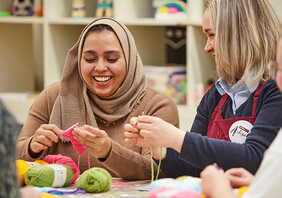How to Make Resin Coasters
Bring the summer vibes into your home with this resin coaster project, featuring a beautiful wave design. Use fluid pigments to add a splash of colour to your resin, this project will be sure to help you feel closer to the sea!
Show off your crafting skills and prepare to amaze all your friends at the dinner table with this stunning and impactful coaster design, or why not make as a gift for someone special!?
Project and instructions by Hobbycraft Artisan Amy Clarke
Warning: You will need to work in a well-ventilated area while working with resin. You will also need to wear a respirator mask and wear disposable gloves.
You will need
You Will Need
* Pebeo Gedeo Bio-Based Glazing Resin 150ml
* Unglazed Ceramic Coasters
* White Self-Adhesive Felt Sheet A4
* Acrylic Paint Markers
* Pouring Cups
* Heat-Resistant Mat
* Scissors
* Heat Gun
* Nitrile Gloves
* Masking Tape
How To Make
You will need to work on a completely level surface for this project. If the coaster is at an angle, then the resin will run off the edge before it has cured. Check with a spirit level or just place something like a marble on your coaster to see if it moves.
To begin, you will need to cover the back of your coaster in masking tape, this will prevent any resin sticking to the bottom of your coaster. Cover in as many strips as needed then trim away the excess.
Tip: Use a plastic cup to raise your coaster above your work mat to stop the resin from running under the coaster and to make removing the tape easier.



Pebeo resin is a two-part compound that needs to be mixed in a two to one ratio: two parts of Resin 'A' to one part hardener 'B'. The kit comes with two handy measuring cups, try to be as precise as possible when measuring out the parts; if the resin is not measured or mixed properly it will not cure successfully. Using 30ml of resin (20ml part A, 10ml Part B), pour both parts into a mixing cup and stir thoroughly for 2 minutes, making sure you scrape along the sides of the cup.
Next, you'll need to add some colour to the resin using fluid pigments. Divide the resin into two cups, I used about two tablespoons of resin and 4 drops of blue in one, and a teaspoon of resin and 4 drops of white in another. This should be enough to cover two coasters.
You will need to leave the resin to thicken slightly as it is a little too thin when first mixed. I left mine for an hour, but this time may vary depending on the temperature of your room as Epoxy resin sets faster in warmer temperatures. Check your resin every ten minutes until it reaches the consistency of runny honey, it should still run off the mixing stick but much more slowly.



Pour the blue resin in a line to create the edge of your wave, about three quarters of the way across your coaster. Then, pour more behind to fill it in, use your mixing stick to spread the resin over the surface in a thin layer. Then, pour a thin line of white resin just in front of the blue.



This is where the magic happens! Take your hair dryer or heat gun, (the hair dryer should be set on the hottest setting, a heat gun on its medium heat setting and a fast speed), then use it to blow along the edge of the resin in one smooth motion. Try to keep the nozzle in a horizontal position and in line with the top of the coaster, this will help push the white resin over the top of the blue. You may need to hold the tip of your coaster to stop it moving under the force of the air.
Tip: Don't over work this, as soon as the white resin is getting near to the back of the coaster, stop. You may not think it looks ok at this stage, but the pattern in the white resin takes a few minutes to develop properly.


Now cover your coaster with a bowl or box to prevent any dust from sticking to the resin then leave to cure for 12 to 24 hours until the resin is firm. You can test by lightly touching the sides to see if the resin is still tacky.

Once the resin has hardened, you will need to pour one final layer on to the top of your coaster. This will create an even surface and change the colour of the unglazed coaster to a lovely sandy colour.
Pour a thin layer along the edge of your wave, just enough so that it spreads to the edge of the coaster. Again, cover and leave to cure.
Resin takes around 24 hours to cure but will not fully harden for a few days, so it's best to leave it for at least 72 hours before using the coasters.
Please note: Very hot cups may leave slight marks on cured resin.

Once the resin is completely set, remove the tape from the back. Use a permanent silver or gold pen to colour around the edge of the coaster, this will neaten it up and make the edge one uniform colour.
You can also back your coaster with adhesive felt which will give a nice soft finish. Just draw around your coaster on to the paper backing of the felt, cut neatly, peel the paper away and stick on.


Your resin wave coaster is now complete!
Repeat this process to create a beautiful collection of resin wave coasters.
Each coaster you make will have a unique pattern.
Why not try changing the shape of your wave? Or add different amounts of blue pigment to make your waves lighter or darker.



















